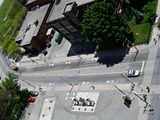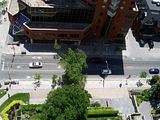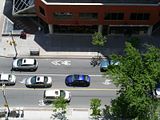Sadly, this is probably too logical for Toronto...
___________________
Idaho Stop one way to fuel 'war on the car'
Why not allow cyclists to essentially treat stop signs as yield signs?
JEFF GRAY
Friday, May. 29, 2009 09:44PM EDT
Any idea to improve conditions for cycling or walking in this city, no matter how small or sensible, now seems likely to be tagged as part of an alleged "war on the car" and used by the mayor's critics on council to appeal to frustrated drivers.
Here's an idea that would light up talk-radio phone lines, even though it would do little more than legalize what many cyclists do every day anyway: It's called the Idaho Stop.
In Idaho, since 1982, cyclists have been allowed to essentially treat stop signs as yield signs, meaning they do not have to come to a complete stop.
Instead, they must slow down to a rolling stop, but must yield right-of-way to other traffic or pedestrians.
In Toronto, this would mean that police officers, when on a bike-safety blitz, would no longer have to sit at sleepy Annex intersections to hand out tickets to librarians in sundresses and would instead have to do something useful.
Almost no cyclist, even the most cautious, stops at stop signs in this city. Dr. Gridlock has previously smugly bragged that he does. But, in fact, he does not. He does Idaho stops.
Bike advocates in Portland - perhaps the U.S. urban cycling capital - appear to have failed in their push to have Oregon adopt an Idaho Stop law, despite arguing bike-car collisions went down in Idaho after it made the change.
Every cyclist knows that coming to a dead stop and starting up again is a pain, as the bicycle's efficient use of your pedal power depends on momentum. Making the current practice of some of the city's responsible cyclists legal might send a positive signal.
But there are many counterarguments, and not just from the get-out-of-my-car's-way crowd. Many cyclists now not only fail to stop, but also they fail to yield right-of-way. Many blow through not just stop signs but (on occasion) red stoplights.
Loosening the rules could lead to even more anarchy and confusion.
The efficiency argument would also prompt some to demand cars adopt Idaho stops to reduce pollution. Few drivers stop properly now, anyway. But cars are inherently more dangerous to pedestrians, cyclists and other cars, and so should perhaps follow different rules.
This brings us back to the city's alleged "war on the car." Two moments stood out in last week's city-council session dominated by this theme, as politicians debated bike lanes on Jarvis Street, a redesign for Roncesvalles Avenue and a test ban, at 10 intersections, of right turns at red lights. (All passed easily.)
One was when Mayor David Miller, scolding his opponents for their "utter nonsense," accused them of being disingenuous in their "war on the car" crusade during the Roncesvalles debate: "The suggestion that this has something to do with a so-called war on the car lies uneasily in the mouths of those who pretended to believe that."
The other moment was provided by Councillor Rob Ford, not exactly seen as a friend of the bike movement, who started his speech with his usual talk-radio shtick, saying cyclists were "a pain in the ass."
But he then proceeded to outline a surprising vision of protected bike paths along the ample boulevards of his Etobicoke ward's high-speed arterial roads.
Perhaps there can one day be a truce in this war after all.













